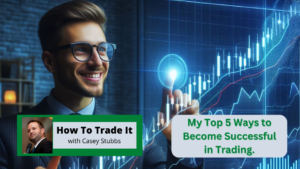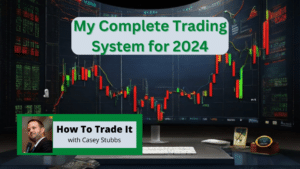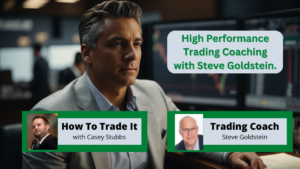Amelia Bourdeau Shares Her Hedge Fund Trading Secrets, Ep #33
Amelia Bourdeau majored in economics and political science in college. After graduating, she was recruited to the Federal Reserve Board during the Asian financial crisis. She worked in the International Finance Division and was working on the Euro project in 1998 up until its launch in 1999. When a senior person at the Fed left and went to Wall Street, she left with them and landed at the Deutsche Bank in NYC. It launched her 15-year Wall Street career.
The first years in Amelia’s career were heavily influenced by world events (9/11, the NASDAQ bubble, recession, etc.). As we have seen before, news trading strategies can be very effective. She learned how competitive the environments were—in a good way. The Fed set a high bar for research. Wall Street was all about staying ahead of the pack. It was a whole new level she wasn’t expecting at the start of her career. But she learned how the markets move. Amelia shares some of her expertise in this episode of How To Trade It.
@AmeliaBourdeau shares some hedge fund trading secrets in this episode of How To Trade It! #stocks #trading #StockMarket #Investing #DayTrading #StockPicks #HedgeFunds #Economy Click To TweetSubscribe to How To Trade It
[maxbutton id=”3″][maxbutton id=”4″][maxbutton id=”5″][maxbutton id=”6″]
You’ll want to hear this episode if you are interested in…
- [1:27] Amelia’s background in finance
- [3:43] What Amelia learned during her tenure
- [5:45] From the Fed to FX Sales
- [11:09] The lingo of foreign exchange
- [12:38] The details on foreign exchange sales
- [14:45] How the banks move the markets
- [21:36] You NEED to follow the event-risk calendar
- [24:58] Amelia’s Global Macro Risk Event webinar
- [28:00] How to connect with Amelia Bourdeau
From the Fed and Wall Street to FX sales and trading
When Amelia was with Deutsche she worked within global markets. Because they were laying off a lot of people, those that were left held multiple jobs. It was difficult, but it allowed her to advance quickly. They put her on the Foreign Exchange trading floor as a strategist. She later worked at UBS in FX as well. It gave her access to talk to some of the world’s largest hedge funds. She also learned about how to day trade.
Toward the latter part of her career, she moved into senior foreign exchange and hedge fund sales. She was responsible for orders, allocating trades, and bringing in business to the bank. At that point, she knew so much about the market but still had to learn the technical aspects. So she worked with salespeople to do mock trades to practice speed and execution. The language in foreign exchange is quite different—so you have to be careful. When she started, she had to master the different lingo and learn to use it correctly. It needs to become intuitive. It was one of the hardest things for her to get down in the beginning. What are FX sales? What are the best buy and sell signals for forex traders? What did a day in Amelia’s life look like? Listen to learn more!
How the banks move the markets
When Amelia was in the markets—especially at Deutsche and UBS—her challenge was the sizing of the trades. At banks, hedge funds would come in and hit you with $50 million or $100 million clicks. As a retail trader, you don’t attempt to stand in the way of central bank flow.
When she was at UBS, they were the largest trader of South African Rand and it was traded via algorithm. She learned to never stand in front of the bank or you’d get run over. The liquidity is too large. But the bottom line is that no one controls the markets. Whatever the market wants to do the market will do. On Wall Street, they say “You don’t want to catch a falling knife.” No one can call the top and the bottom.
@AmeliaBourdeau shares her thoughts on how the banks move the markets in this episode of How To Trade It. Check it out! #stocks #trading #StockMarket #Investing #DayTrading #StockPicks #HedgeFunds #Economy Click To TweetWhy you NEED to track the event-risk calendar
Amelia advises any trader to follow the event-risk calendar. When she was at UBS they had daily meetings about event risks coming up for the day: Is there an essential banker speaking? Is there a Fed meeting that day? What time is the press conference? Are there major data releases today? There is so much going on that you have to pick the events that you think will move the market the most. Using a basic forex economic calendar can be extremely helpful.
Amelia has run into a lot of retail traders that are Elliott-Wave traders or technical traders and don’t follow the economic calendar. Amelia couldn’t understand it. So she launched a webinar to go over global macro event risks. She pinpoints themes and dates to follow when the market is more likely to move. It would be helpful to know if a certain currency is more likely to break a range or break a level.
Amelia’s Global Macro Risk Event webinar
Amelia’s Global Macro Risk Event webinar watches event risks and macro themes that are driving the market. It’s all about finding correlations in the market and tracking them. Amelia often tracks correlations between the dollar and the S&P 500. Sometimes, the correlation changes because something bad is happening.
In the last two weeks, I’ve noticed that the dollar is strongly correlated to the S&P 500. In 2019, Amelia did really well with trading USD/JPY with the S&P 500 or with Apple. Apple would be down and the JPY would be strong. It worked well throughout 2019 but doesn’t work at all in 2020. Amelia uses TD Ameritrade to chart the S&P 500 and USD. If you look at it week to week and month to month you’ll see changes in the charts.
There’s so much changing with the market and there are a lot of macro things going on that are driving the markets. Everything Amelia talks about in her webinar is cross-market and will apply to anyone.
@AmeliaBourdeau talks about her Global Macro Risk Event webinar and how important it is to track events in this episode of How To Trade It. Check it out! #stocks #trading #StockMarket #Investing #DayTrading #StockPicks #HedgeFunds #Economy Click To TweetResources & People Mentioned
- Market Compass LLC
- The United Bank of Switzerland
- Deutsche Bank
- Exante Data
Connect with Amelia Bourdeau
Connect With Casey Stubbs
- Website: https://caseystubbs.com
- Subscribe! https://www.youtube.com/caseystubbs
- Twitter: https://www.twitter.com/caseystubbs
- Facebook: https://www.facebook.com/caseystubbs
- LinkedIn: https://www.linkedin.com/in/caseystubbs/
- Newsletter: https://tradingstrategyguides.ewebinar.com/webinar/live-workshop-learn-the-simple-baseline-strategy-13152
Subscribe to How To Trade It








